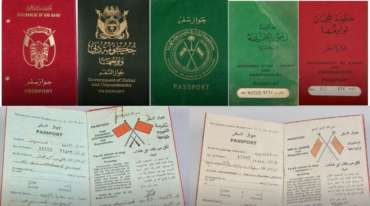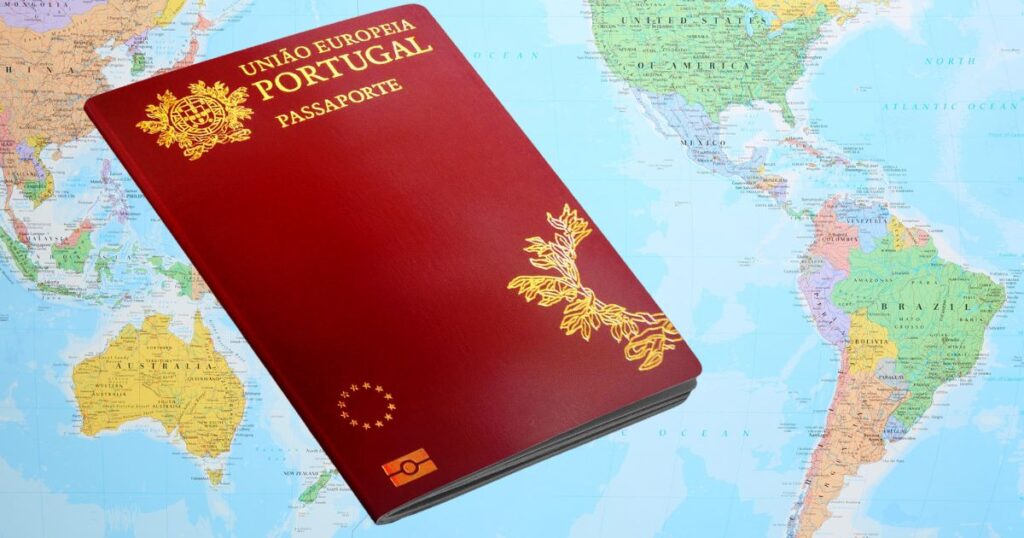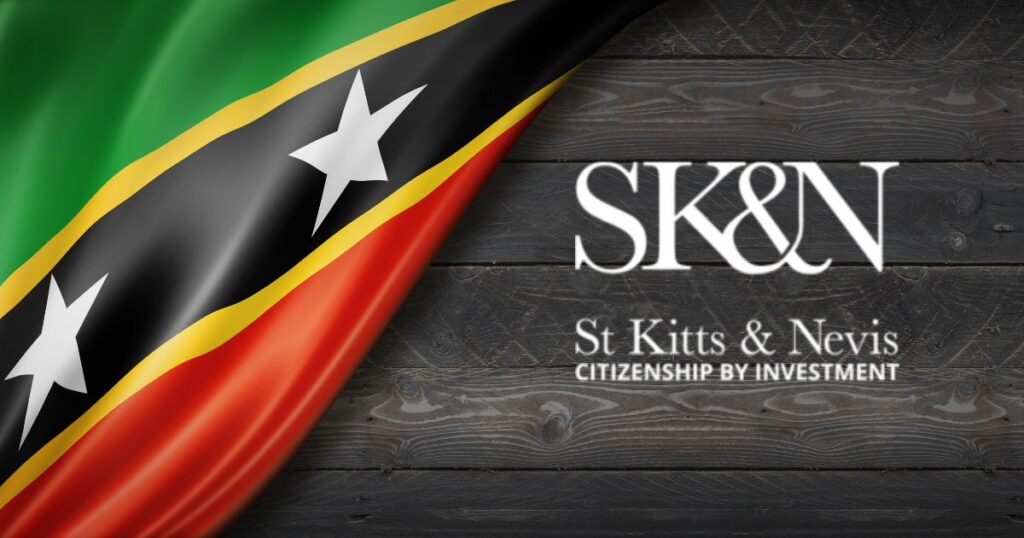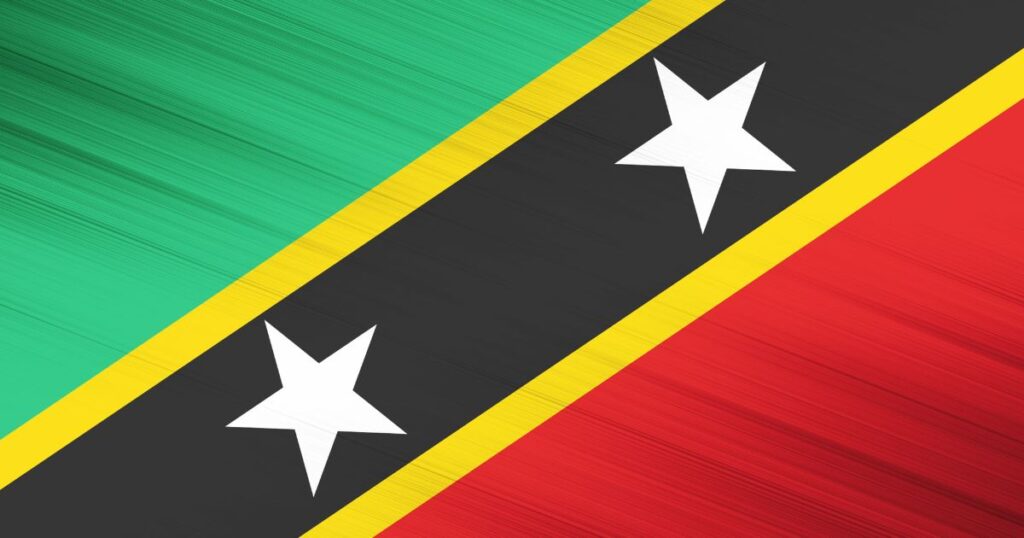The First UAE passport was issued in 1971 after independence. It was black in colour. Later it changed to navy-blue colour. The passports went through a tumultuous history starting in the 1950’s. During that time, each emirate had its own passport document, which was just a piece of paper called ‘Barwa’. In the 1960’s, booklet passports were first introduced.
History
The UAE was formerly known as the Trucial States, a collection of sheikhdoms (Abu Dhabi; Ajman; Dubai; Ras al-Khaima; Sharjah; and Umm al-Quwain.). The Trucial States were a British protectorate that existed from 1820 to 1971 before becoming the nation of the United Arab Emirates.
During the early 1940s, those who wanted to travel abroad would have to get a sheet of paper called a “certificate of identity”, as an alternative for a passport, from the British consulate in their emirate. (there were no passports issued during this time). Printed in English, the paper would be signed by “British government in Trucial Oman”, and would be accompanied by a photograph of the bearer, a physical description of the holder, such as eye colour and height, and the issue and expiry dates.
Some time later, each emirate began issuing its own passport, signed by the Ruler. It was at first a sheet of identity paper in Arabic, similar in form to that previously issued by the British. All people used to travel to the Gulf states, or to East Asia and some African coast to trade, and these travel passes used to be issued by the Customs Office in the Office of the Ruler at the time.
Before UAE independence, each of the emirates had its own passport and regulations. Each emirate used to issue its own passport, which was called (‘Barwa’) at the commencement of 1950s. It was a one paper document valid for one year only.
Later at the end of 1950s, the passport of the Trucial States (Red) was issued with a validity period of two years from the date of its issuance, and can be renewed for four more times, provided that each period does not exceed two years. It could be used to travel to all States mentioned in the fourth page.
After the formation of the Union in 1971, the first passport was issued in black color imprinted of the national symbols, the falcon and the UAE flag.. It was issued and renewed by the Directorate of Passports of the Federal Ministry of the Interior and by the diplomatic missions and UAE consulates abroad, where applications were submitted for this purpose. This passport was valid only for two years from the date of its issuance, and could be renewed twice for similar periods, so that the total period of validity of the passport was six years from the date of issuance. It was used to travel to the States indicated therein.
All UAE nationals hold the UAE passport, which reflects the spirit of the union of the seven emirates. This is as per Federal Law No. 17 of 1972 Concerning Nationality and Passports.
In 2011, the Ministry of the Interior began to issue machine-readable passports or electronic passports to UAE nationals in accordance with the technical and security requirements of the International Civil Aviation Organization (ICAO). Emirati passports issued since 11 December 2011 have been biometric passports. The first page of the passport contains a watermark of the outer frame of Sheikh Zayed Grand Mosque, while its last page is adorned with the actual painting of the mosque with domes and columns.
We take a look at the Trucial UAE Passports issued before 1971
Abu Dhabi
The Abu Dhabi passport had a red canvas cover with golden inscriptions featuring a representation of the coat of arms of the Emirate of Abu Dhabi at the center, with an open winged falcon sitting on a pair of daggers in saltire, at the back of the falcon are two flags with a decorated banner with the words ‘Government of Abu Dhabi’ inscribed in Arabic.

The Abu Dhabi passport had a red canvas cover with golden inscriptions featuring a representation of the coat of arms of the Emirate of Abu Dhabi at the center, with an open winged falcon siting on a pair of daggers in saltire, at the back of the falcon are two flags with a decorated banner with the words ‘Government of Abu Dhabi’ inscribed in Arabic.
Dubai
Dubai is the most populous emirate in the UAE. It is bordered to the south by the Emirate of Abu Dhabi and to the northeast by the Emirate of Sharjah. Dubai is a centre for regional and international trade since the early 20th century, and a major global transport hub for passengers and cargo.
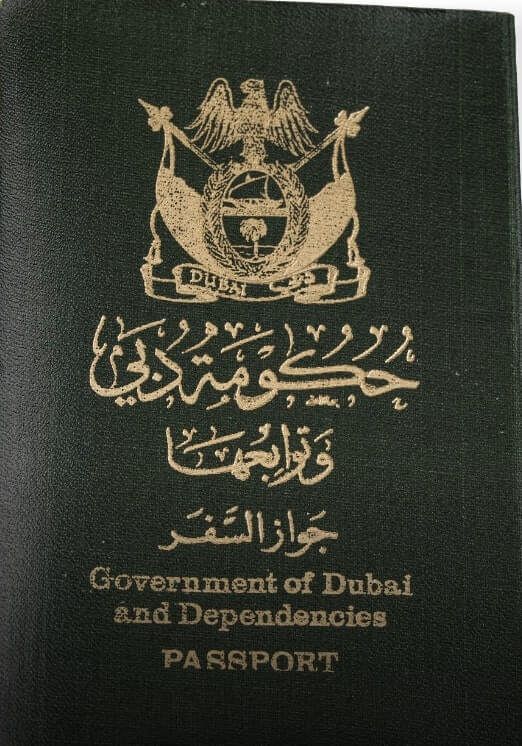
The Dubai passport had a black cover with golden inscriptions featuring a representation of the coat of arms of the Emirate of Dubai at the top, with an open winged falcon on an oval within which is a Dhow (a ship with two masts, a high stern and a low straight bow) at sea and a palm tree in the desert, enclosed within a laurel wreath. In the background is a pair of flags in saltire and at the bottom is a parchment with ‘Dubai’ written in English on the left and in Arabic on the right.
Sharjah
A ‘Government of Sharjah & Dependencies’ Passport Issued Prior to the Unification of The United Arab Emirates in 1971
Sharjah is the third largest and third most populous emirate in the UAE. It borders with Dubai to the south, Ajman and Umm Al Quwain to the north and Ras Al Khaimah to the east. It is the only emirate that overlooks the coastline on the Arabian Gulf to the west and the Gulf of Oman to the east.
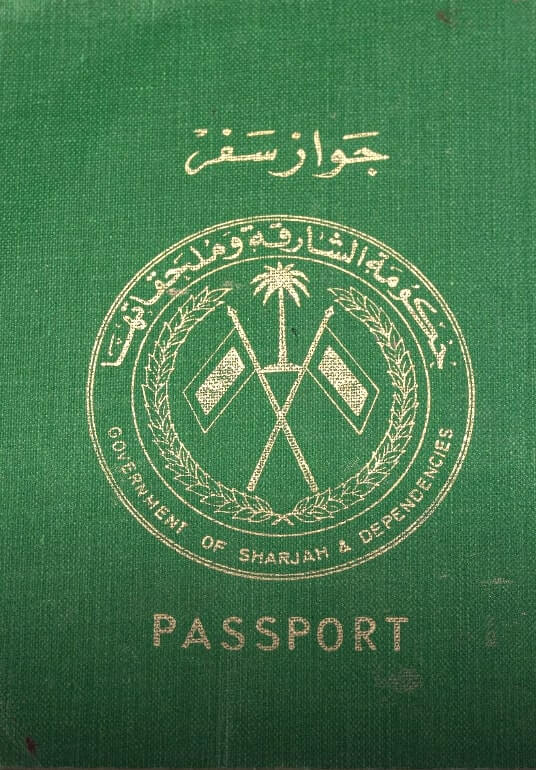
The Sharjah passport had a green canvas cover and featured a representation of the coat of arms of the Emirate of Sharjah at the center, with a palm tree, below which are two flags in saltire encircled with a laurel wreath and the words ‘Government Of Sharjah & Dependencies’ appear on the outer circle in Arabic on top and English at the bottom.
Ajman
A ‘Government of Ajman and Dependencies’ Passport Issued Prior to the Unification of the United Arab Emirates in 1971
Ajman is the fourth most populous emirate in the UAE, and the smallest of the seven emirates in terms of area. The main landmass of the emirate is bordered on the north, east and south by the Emirate of Sharjah.
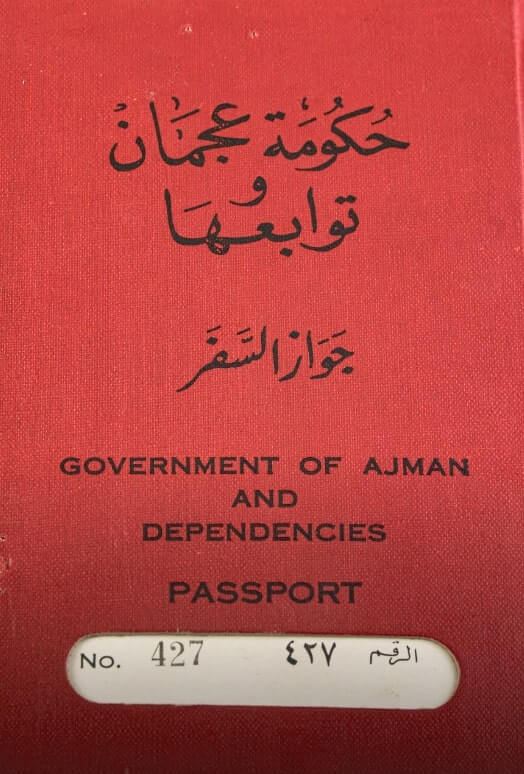
The Ajman passport had a red canvas cover and black lettering, it opens in the Arabic style (left-hand side), and the words ‘Government Of Ajman And Dependencies’ & ‘Passport’ are marked on the cover in Arabic (top) and in English (below).
Umm Al Quwain
An ‘Umm Al Quwain’ (Trucial States) Passport Issued Prior to the Unification of the United Arab Emirates in 1971
Umm Al Quwain is situated between Sharjah to the southwest and Ras Al Khaimah to the northeast. It is the second smallest and the least populated emirate in the UAE. Fishing is a key contributor to the economy of Umm Al Quwain. The emirate exports seafood throughout Europe and the Middle East.
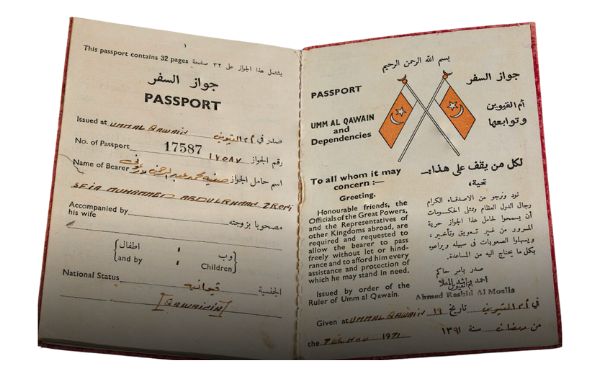
A ‘Government of Ras Al Khaimah and Dependencies’ Passport Issued Prior to the Unification of the United Arab Emirates in 1971
Ras Al Khaimah is located in the northern part of the United Arab Emirates. It borders with Oman and with three other Emirates which are Umm Al Quwain, Sharjah, and Fujairah. The emirate has a mountain range called the Ru’us Al Jibal, which is part of the Hajar Mountains. The mountain range incorporates Jebel Jais, which at 1,934m, is the highest peak in the UAE.
The Government of Ras Al Khaimah and Dependencies passport had a green canvas cover and black lettering, it opens in the Arabic style (left-hand side), and the words ‘Government Of Ras Al Khaimah And Dependencies Passport’ are marked on the cover in Arabic (top) and in English (below).
Fujairah
A ‘Government of Fujairah and Dependencies’ Passport Issued Prior to the Unification of the United Arab Emirates in 1971
Fujairah is the only emirate that is located completely on the eastern coast of the UAE along the Gulf of Oman. The shores of Fujairah extend along the Gulf of Oman for about 70km, from the city of Fujairah in the south to the town of Dibba in the far north.
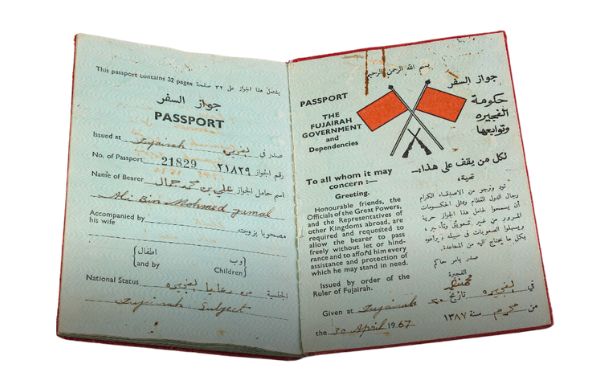
Due to its strategic position, it is the UAE’s only access to the Indian Ocean. It operates a multipurpose port that offers access to major shipping routes of the world.
UAE Passport 1971
The individual emirates continued to issue their own passports until the federation was formed on December 2, 1971. With the birth of the nation, one UAE passport was issued to all of its citizens. It has a black cover, consists of 60 pages, each with an imprint of the national symbols, the falcon and the UAE flag.
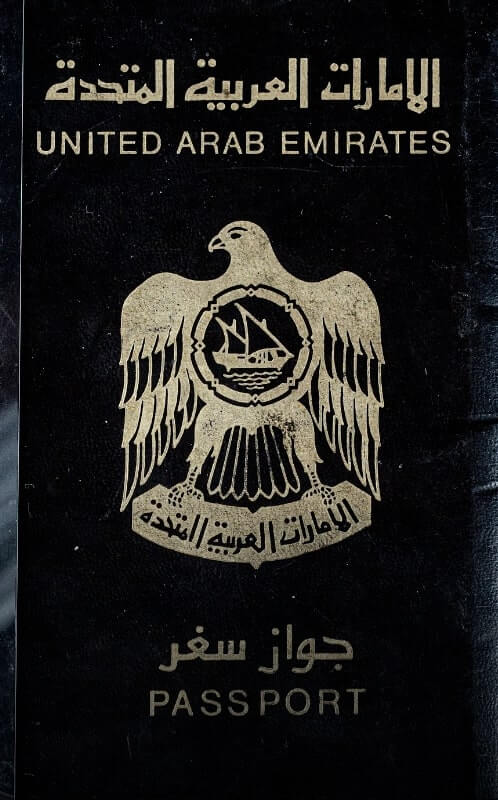
All Picture/Credit: Etihad Museum
Modern Changes
In 2011, the Ministry of the Interior began to issue machine-readable passports or electronic passports to UAE nationals in accordance with the technical and security requirements of the International Civil Aviation Organization (ICAO).
Image Source: Wikipedia
The electronic passport is characterised by high technical and security features. The last page contains a remote-readable electronic chip that stores the personal and biometric data of the passport holder. This chip is encrypted to prevent counterfeiting. The image, signature, and fingerprints are printed and cannot be modified. The first page of the passport contains a watermark of the outer frame of Sheikh Zayed Grand Mosque, while its last page is adorned with the actual painting of the mosque with domes and columns.
Museums
If you visit UAE, there are several museums to explore for passport collectors. There is an example of a 1960s Emirati passport can be seen at the Ajman National Museum. Enclosed in a glass display case is passport “no. 1”, which belonged to the Ruler of Ajman, Sheikh Rashid bin Humaid Al Nuaimi (1928-1981).
There is also unique collection at the Etihad Museum.
The Al Dana Museum at the General Directorate of Residency and Foreigners Affairs in Dubai has a nice exhibits . It has a good collection of important documents, for young Emiratis must see to understand their country’s past.

